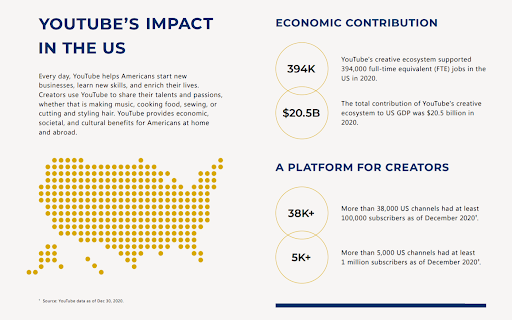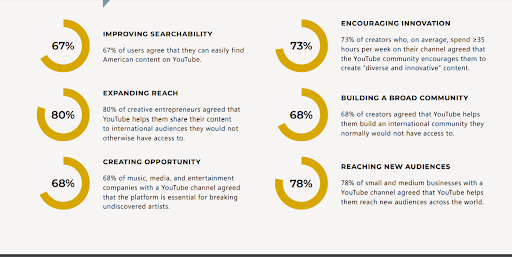YouTube has recently published a report, boasting the positive impact it has had on the global economy, thanks in no short part to its YouTube Partnership Program sponsoring over 2 million creators.
This report was published in conjunction with Oxford Economics, and is labelled “The State of the Creator Economy”. Accordingly, the paper goes on to discuss not just YouTube’s impact on the US GDP, but also discusses the overall impact creator culture has had on society and culture. The contents of the article can be read in their entirety on the Oxford Economics website. In this article, we’ll instead be limiting ourselves to discussing a few relevant points, while also adding in a bit of personal opinion to the mix.
The YouTube ecosystem has generated over 394,000 jobs in 2020, with hours and pay rates being equivalent to those of full-time jobs. With this amount of work being generated, it’s no surprise that the overall GDP generated for the USA landed at an incredible USD $20.5 billion. YouTube’s come far from 2005, having grown from a tight-knit community of creators to a thriving population of thousands, with entire merchandise stories, small businesses, Patreons, and exclusive shows to boot. A lot of YouTubers have even managed to make their way into Hollywood stardom, with creators such as Awkwafina and Flula Borg making it into huge productions such as Shang Chi and The Suicide Squad respectively.
Creators are also finding themselves in a period of expansion unlike any that’s been seen before. More than 38,000 channels in the USA have over 100,000 subscribers as of December 2020. Other than that, over 5,000 channels have over a million subscribers. That’s without talking about the heavy influence creators from South Korea, India, and Brazil have had on the platform. Much of this comes in the form of YouTube’s Partnership Program, which has actively sponsored the careers of approximately 2 million creators on the platform, leading to such a massive overall growth in both GDP and quality content.
YouTube’s report comes at a time where the existence of social media is being rather severely judged by both social and political conventions. While Facebook and TikTok have taken the brunt of the criticism, the video sharing platform isn’t all too safe either. YouTube has received its own barrage of criticism over its algorithm favoring videos featuring creators going against each other, and portraying lifestyles that are both mentally and physically damaging. It’s also been heavily scrutinized for allowing anti-vaccine rhetoric and COVID naysayers to generate fear mongering, baseless content with little to no repercussions. Perhaps this 2020 study is more than just a highlight of YouTube’s success. Perhaps it's a reminder to the public and government sector of just how important the platform has become to both our economy and culture.
This report was published in conjunction with Oxford Economics, and is labelled “The State of the Creator Economy”. Accordingly, the paper goes on to discuss not just YouTube’s impact on the US GDP, but also discusses the overall impact creator culture has had on society and culture. The contents of the article can be read in their entirety on the Oxford Economics website. In this article, we’ll instead be limiting ourselves to discussing a few relevant points, while also adding in a bit of personal opinion to the mix.
The YouTube ecosystem has generated over 394,000 jobs in 2020, with hours and pay rates being equivalent to those of full-time jobs. With this amount of work being generated, it’s no surprise that the overall GDP generated for the USA landed at an incredible USD $20.5 billion. YouTube’s come far from 2005, having grown from a tight-knit community of creators to a thriving population of thousands, with entire merchandise stories, small businesses, Patreons, and exclusive shows to boot. A lot of YouTubers have even managed to make their way into Hollywood stardom, with creators such as Awkwafina and Flula Borg making it into huge productions such as Shang Chi and The Suicide Squad respectively.
Creators are also finding themselves in a period of expansion unlike any that’s been seen before. More than 38,000 channels in the USA have over 100,000 subscribers as of December 2020. Other than that, over 5,000 channels have over a million subscribers. That’s without talking about the heavy influence creators from South Korea, India, and Brazil have had on the platform. Much of this comes in the form of YouTube’s Partnership Program, which has actively sponsored the careers of approximately 2 million creators on the platform, leading to such a massive overall growth in both GDP and quality content.
YouTube’s report comes at a time where the existence of social media is being rather severely judged by both social and political conventions. While Facebook and TikTok have taken the brunt of the criticism, the video sharing platform isn’t all too safe either. YouTube has received its own barrage of criticism over its algorithm favoring videos featuring creators going against each other, and portraying lifestyles that are both mentally and physically damaging. It’s also been heavily scrutinized for allowing anti-vaccine rhetoric and COVID naysayers to generate fear mongering, baseless content with little to no repercussions. Perhaps this 2020 study is more than just a highlight of YouTube’s success. Perhaps it's a reminder to the public and government sector of just how important the platform has become to both our economy and culture.





